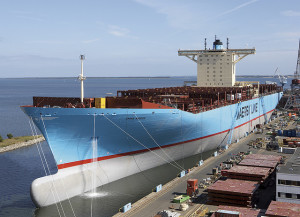 The year 2015 is shaping up to be another year of oversupply for the container shipping industry, as the slew of arrivals of big ships is expected to continue and further widen the gap with demand on the East-West trade lane, making recovery harder, predicts Drewry.
The year 2015 is shaping up to be another year of oversupply for the container shipping industry, as the slew of arrivals of big ships is expected to continue and further widen the gap with demand on the East-West trade lane, making recovery harder, predicts Drewry.
In its latest “Container Forecaster,” Drewry said the unabated delivery of ultra-large container vessels (ULCVs) will continue into 2015, and this “will make it harder for carriers to repeat the estimated 92% load factors across the main headhaul East-West trade lanes achieved in 2014.”
New orders for ULCVs of at least 18,000 twenty-foot equivalent units (TEUs) are pushing back the date when supply and demand can be expected to meet, and at the individual trade route level this is now seemingly unachievable, added Drewry. There have been around 40 ULCVs ordered since January, mainly for 2017 delivery and this does not include any provision for Maersk and Cosco orders yet to be finalized.
“The industry paid a heavy price for the huge ordering it undertook in 2006/07 and it seems that four years after Maersk spent $3.8 billion on its Triple Es, history is repeating and many lines are entering or are about to enter this now not so exclusive club. The one difference this time around is that the operational agreements should mean that not all top 20 lines will make this big step,” said Neil Dekker, director of container research at Drewry.
A bright spot for the industry is the recent resolution of the labor conflict between terminal operators and workers on the U.S. West Coast. But Drewry estimates that its toll on the industry during the last three months of 2014 amounted to $150 million, not including the impact on associated supply chain networks, which cannot necessarily be measured in dollars.
The 30% fall in bunker prices has also been an unexpected boon, but most carriers still recorded lower average freight rates last year. This, said Drewry, still indicates a disconnect in the industry, especially with recent indicators in 2015 highlighting declining spot freight rates.
The underperformance of the trades to East Coast South America is another concern for the global cascade of vessels over 8,000 TEUs.
“The decision by Maersk and MSC to downgrade the average size of ships on one of their European strings to the East Coast of South America from 9,000 teu to 5,500 teu may not seem particularly important in the grand scheme of things. But all ocean carriers have argued that deploying new and big ships across every trade route is strategically critical. This is the first sign that on routes where trade growth is weak, the lower slot cost per unit argument is simply not enough because freight rates dive to well below sub-economic levels,” said Dekker.
Ships’ on-time reliability improves
Meanwhile, according to Drewry’s latest “Carrier Performance Insight,” liner shipping service reliability across the three core East-West trades hit a five-month peak in March with an aggregate on-time performance of 64%.
The latest result represents an 8.5 percentage point gain over February and is the second best average (after October 2014) since the start of the new data series in May 2014.
The improvement seen in March was the result of much improved services in the Asia-Europe trade and gradually easing congestion on the U.S. West Coast following the resolution of the port labor dispute. However, services on the trans-Atlantic took a backward step in the month.
The most reliable carrier in March was Maersk Line with an average on-time performance of 81%, followed by “K” Line (73%), Cosco, and MSC (both 70%). At the bottom of the rankings were Zim (39%) and PIL (38%).
“It is good news for shippers that service reliability is on the rise, although it comes from a low base and the industry average still has plenty more scope to improve. We expect the upwards trend to continue as USWC operations return to normal, but the sharp drop in Asia-Europe freight rates is a risk as carriers could look to make cost savings detrimental to reliability,” said Simon Heaney, senior manager of supply chain research at Drewry.
Photo: Tidewater Muse





